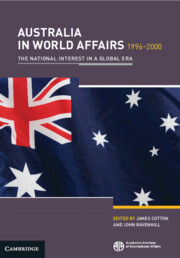Book contents
- Frontmatter
- Contents
- Figure
- Contributors
- Preface
- Abbreviations
- Part I Setting the Scene
- Part II Relationships
- 4 Australia’s Relations with South Asia
- 5 Australia and Japan1
- 6 Peripheral Relations: Australia and Latin America
- 7 Australia and China: Divergence and Convergence of Interests1
- 8 Australia and Europe
- 9 Reassessing Australia’s Role in Papua New Guinea and the Island Pacific1
- 10 Australia and the United States
- Part III Issues
- References
- Index
8 - Australia and Europe
from Part II - Relationships
Published online by Cambridge University Press: 04 May 2024
- Frontmatter
- Contents
- Figure
- Contributors
- Preface
- Abbreviations
- Part I Setting the Scene
- Part II Relationships
- 4 Australia’s Relations with South Asia
- 5 Australia and Japan1
- 6 Peripheral Relations: Australia and Latin America
- 7 Australia and China: Divergence and Convergence of Interests1
- 8 Australia and Europe
- 9 Reassessing Australia’s Role in Papua New Guinea and the Island Pacific1
- 10 Australia and the United States
- Part III Issues
- References
- Index
Summary
Following two centuries of white settlement and several ’waves’ of immigration, many Australians retain a sense of identification with European cultures and societies. This is despite understandable and fairly successful efforts to focus on cultivating a national identity and diminished support among political élites for the project of fostering cultural links with Europe. The Australian tendency to associate immigration with waves of European immigrants landing on Australian shores picks up on only part of the story. There has also been movement in the opposite direction, with many Australians migrating to Europe. This trend may well increase among those able to apply their skills in European labour markets. It reflects a degree of cosmopolitanism, and the capacity of many Australians to adapt to different cultures. For most Australians this adaptation appears to be easiest in English-speaking cultures, particularly the United Kingdom. There is also a strong resonance for Australians with aspects of North American culture, and powerful incentives to migrate to that continent among those with marketable knowledge-based skills.
Keywords
- Type
- Chapter
- Information
- Australia in World Affairs 1996–2000The National Interest in a Global Era, pp. 91 - 103Publisher: Cambridge University PressFirst published in: 2024

